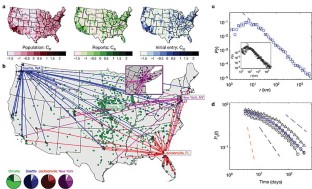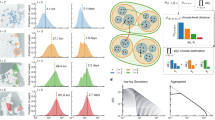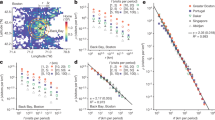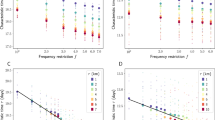Abstract
The dynamic spatial redistribution of individuals is a key driving force of various spatiotemporal phenomena on geographical scales. It can synchronize populations of interacting species, stabilize them, and diversify gene pools1,2,3. Human travel, for example, is responsible for the geographical spread of human infectious disease4,5,6,7,8,9. In the light of increasing international trade, intensified human mobility and the imminent threat of an influenza A epidemic10, the knowledge of dynamical and statistical properties of human travel is of fundamental importance. Despite its crucial role, a quantitative assessment of these properties on geographical scales remains elusive, and the assumption that humans disperse diffusively still prevails in models. Here we report on a solid and quantitative assessment of human travelling statistics by analysing the circulation of bank notes in the United States. Using a comprehensive data set of over a million individual displacements, we find that dispersal is anomalous in two ways. First, the distribution of travelling distances decays as a power law, indicating that trajectories of bank notes are reminiscent of scale-free random walks known as Lévy flights. Second, the probability of remaining in a small, spatially confined region for a time T is dominated by algebraically long tails that attenuate the superdiffusive spread. We show that human travelling behaviour can be described mathematically on many spatiotemporal scales by a two-parameter continuous-time random walk model to a surprising accuracy, and conclude that human travel on geographical scales is an ambivalent and effectively superdiffusive process.
This is a preview of subscription content, access via your institution
Access options
Subscribe to this journal
Receive 51 print issues and online access
$199.00 per year
only $3.90 per issue
Buy this article
- Purchase on Springer Link
- Instant access to full article PDF
Prices may be subject to local taxes which are calculated during checkout


Similar content being viewed by others
References
Bullock, J. M., Kenward, R. E. & Hails, R. S. (eds) Dispersal Ecology (Blackwell, Malden, Massachusetts, 2002)
Murray, J. D. Mathematical Biology (Springer-Verlag, New York, 1993)
Clobert, J., Danchin, E., Dhondt, A. A. & Nichols, J. D. (eds) Dispersal (Oxford Univ. Press, Oxford, 2001)
Nicholson, K. & Webster, R. G. Textbook of Influenza (Blackwell, Malden, Massachusetts, 1998)
Grenfell, B. T., Bjornstadt, O. N. & Kappey, J. Travelling waves and spatial hierarchies in measles epidemics. Nature 414, 716–723 (2001)
Keeling, M. J. et al. Dynamics of the 2001 UK foot and mouth epidemic: stochastic dispersal in a heterogeneous landscape. Science 294, 813–817 (2001)
Hudson, P. J., Rizzoli, A., Grenfell, B. T. & Heesterbeek, H. (eds) The Ecology of Wildlife Diseases (Oxford Univ. Press, Oxford, 2002)
Hufnagel, L., Brockmann, D. & Geisel, T. Forecast and control of epidemics in a globalized world. Proc. Natl Acad. Sci. USA 101, 15124–15129 (2004)
Grassly, N. C., Fraser, C. & Garnett, G. P. Host immunity and synchronized epidemics of syphilis across the United States. Nature 433, 417–421 (2005)
Webby, R. J. & Webster, R. G. Are we ready for pandemic influenza? Science 302, 1519–1522 (2003)
Kot, M., Lewis, M. A. & van den Driessche, P. Dispersal data and the spread of invading organisms. Ecology 77, 2027–2042 (1996)
Shlesinger, M. F., Zaslavsky, G. M. & Frisch, U. (eds) Lévy Flights and Related Topics in Physics (Springer Verlag, Berlin, 1995)
Klafter, J., Shlesinger, M. F. & Zumofen, G. Beyond Brownian motion. Phys. Today 49, 33–39 (1996)
Brockmann, D. & Geisel, T. Lévy flights in inhomogeneous media. Phys. Rev. Lett. 90, 170601 (2003)
Metzler, R. & Klafter, J. The random walks guide to anomalous diffusion: a fractional dynamics approach. Phys. Rep. 339, 1–77 (2000)
Shlesinger, M. F., Klafter, J. & Wong, Y. M. Random-walks with infinite spatial and temporal moments. J. Stat. Phys. 27, 499–512 (1982)
Nathan, R. The challenges of studying dispersal. Trends Ecol. Evol. 16, 481–483 (2001)
Viswanathan, G. M. et al. Lévy flight search patterns of wandering albatrosses. Nature 381, 413–415 (1996)
Ramos-Fernandéz, G., Mateos, J. L., Miramontes, O. & Cocho, G. Lévy walk patterns in the foraging movements of spider monkeys. Behav. Ecol. Sociobiol. 55, 223–230 (2004)
Levin, S. A., Muller-Landau, H. C., Nathan, R. & Chave, J. The ecology and evolution of seed dispersal: A theoretical perspective. Annu. Rev. Ecol. Evol. Syst. 34, 575–604 (2003)
Nathan, R. et al. Mechanisms of long-distance dispersal of seeds by wind. Nature 418, 409–413 (2002)
Gardiner, C. W. Handbook of Stochastic Methods (Springer Verlag, Berlin, 1985)
Montroll, E. W. & Weiss, G. H. Random walks on lattices. J. Math. Phys. 6, 167–181 (1965)
Acknowledgements
We would like to thank the initiators of the bill tracking system (www.wheresgeorge.com). We thank cabinetmaker D. Derryberry for discussions and for drawing our attention to the wheresgeorge website, and B. Shraiman, D. Cohen and W. Noyes for critical comments on the manuscript. Author Contributions The project idea was conceived by D.B. and L.H., data pre-processing was done by L.H., data analysis by D.B. and L.H., the theory and model was constructed by D.B., and the manuscript was written by D.B., L.H. and T.G.
Author information
Authors and Affiliations
Corresponding author
Ethics declarations
Competing interests
Reprints and permissions information is available at npg.nature.com/reprintsandpermissions. The authors declare no competing financial interests.
Supplementary information
Supplementary Notes 1
Calibration against independent human travel datasets (PDF 637 kb)
Supplementary Notes 2
Theory of Lévy flights and continuous time random walks (CTRW) (PDF 580 kb)
Supplementary Notes 3
Relaxation time of two dimensional pure Lévy flights in a confined region (PDF 38 kb)
Supplementary Notes 4
Similarities between the dispersal of bank notes and infectious diseases (PDF 86 kb)
Rights and permissions
About this article
Cite this article
Brockmann, D., Hufnagel, L. & Geisel, T. The scaling laws of human travel. Nature 439, 462–465 (2006). https://doi.org/10.1038/nature04292
Received:
Accepted:
Issue Date:
DOI: https://doi.org/10.1038/nature04292
This article is cited by
-
Human emergency behaviour and psychological stress characteristic mining based on large-scale emergencies
Computational and Mathematical Organization Theory (2024)
-
A return-to-home model with commuting people and workers
Journal of Mathematical Biology (2024)
-
Common features in spatial livestock disease transmission parameters
Scientific Reports (2023)
-
The diffusion metrics of African swine fever in wild boar
Scientific Reports (2023)
-
Epidemic thresholds and human mobility
Scientific Reports (2023)
Comments
By submitting a comment you agree to abide by our Terms and Community Guidelines. If you find something abusive or that does not comply with our terms or guidelines please flag it as inappropriate.



